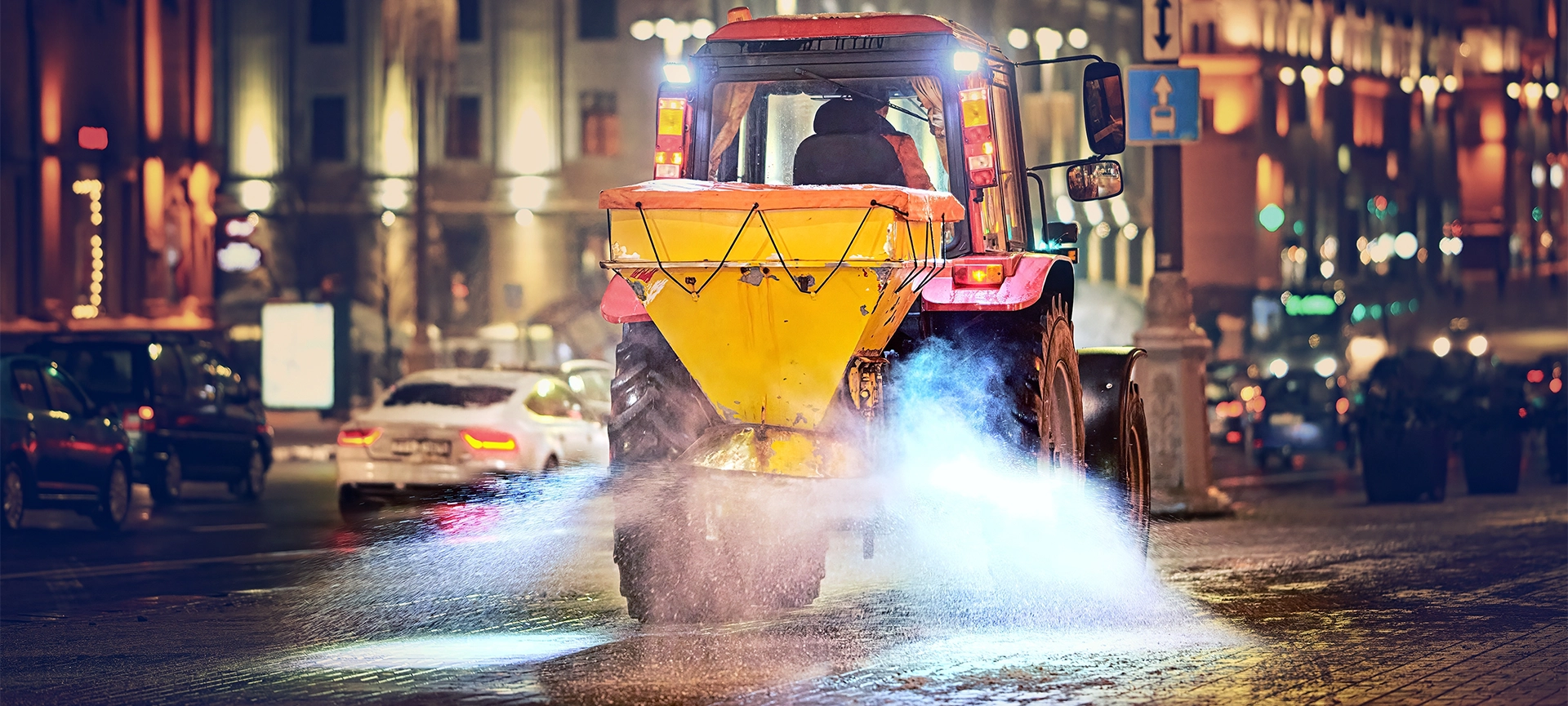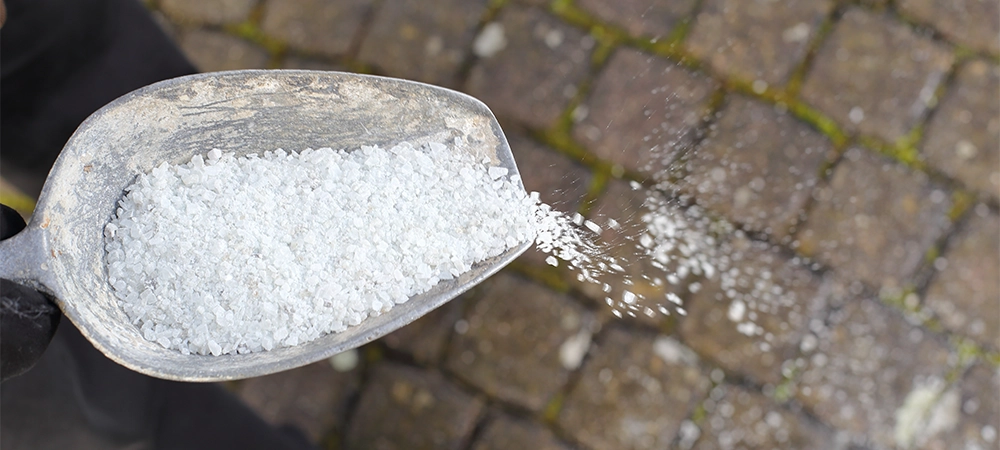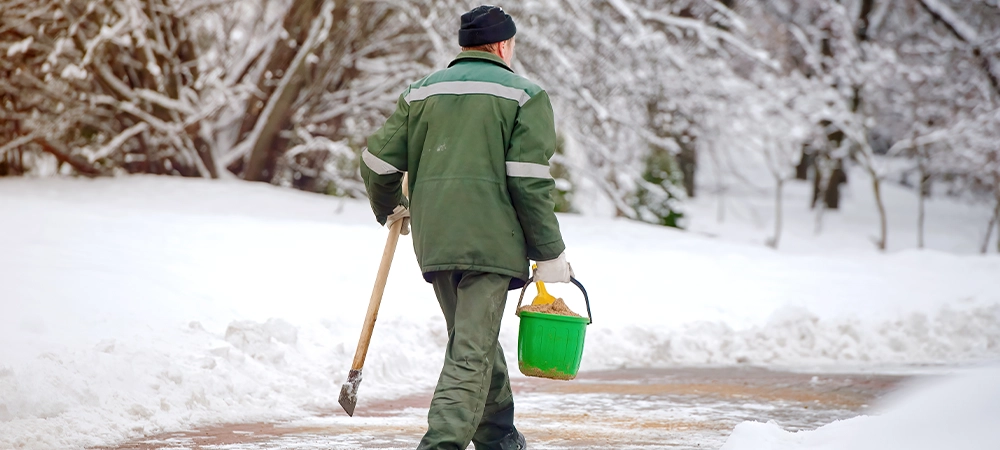Best Practices for Salting and De-Icing in Commercial Areas

When winter hits, icy surfaces can bring commercial activity to a standstill. A slippery entrance or frozen loading bay doesn’t just slow operations; it can trigger accidents, lawsuits, and costly downtime. For retail plazas, office parks, healthcare facilities, and distribution yards, winter safety is as much about liability control as it is about customer and staff well-being.
The good news is that proven salting and de-icing strategies can limit those risks. With the right products, applied at the right times and in the right amounts, you can keep surfaces safe, protect pavement, and keep business moving all season long.
Related Article: What’s Included in a Private Road Snow Removal Service?
Start With a Site Assessment
Every property is different. Before the snow starts falling, it pays to know your site inside and out. Walk the grounds and create a detailed map:
- Mark slopes, ramps, and areas where ice tends to form first.
- Identify drainage points, downspouts, and shaded corners that stay colder.
- Measure the parking lot square footage so you can calculate product needs more accurately.
- Note sensitive areas (e.g. landscaping, metal railings, or drainage grates) that could be damaged by overuse of salt.
Taking the time to map risk zones ensures crews know exactly where to focus when conditions turn icy. It also prevents wasted product and helps you budget better for the season.
Choosing the Right De-Icing Material
There is no single “best” salt for every job. The right product depends on temperature, surface type, environmental concerns, and cost. Here’s a breakdown of the most common options.
Rock Salt (Sodium Chloride)
- Effective down to about -9 °C
- Most affordable option, ideal for large open lots
- Can burn grass and corrode steel if over-applied
Rock salt is the workhorse of winter maintenance. It’s reliable, easy to spread, and inexpensive. The drawback? It’s harsh on the environment and nearby landscaping, so leftover salt should be swept after surfaces are clear.
Calcium Chloride Pellets
- Works down to -29 °C
- Generates heat as it dissolves, melting ice quickly
- More expensive but requires less product
This is the go-to for very cold nights, steep ramps, or high-traffic areas that need fast results. It’s efficient but needs careful storage because it absorbs moisture quickly.
Magnesium Chloride Flakes
- Effective to about -15 °C
- Gentler on surfaces and plants than sodium chloride
- Adds dust-control benefits in underground garages
Magnesium chloride is a balanced choice when you want effective melting without as much corrosion risk. It’s especially useful for properties with lots of concrete or landscaped areas nearby.
Potassium Acetate and Formates
- Safe for reinforced concrete and environmentally friendly
- Performs well in very low temperatures
- Costly, so best reserved for healthcare sites or heritage properties
These premium products are often seen at airports or hospitals. They’re ideal when surface protection and environmental safety are priorities, even if the price is higher.
Related Article: Is De-Icing Enough? When You Need Full-Service Ice Management

Why Brine is Gaining Ground
Many commercial properties are shifting from dry salt to liquid brine. Brine is a salt solution sprayed directly on pavement before a storm. It creates a thin layer that prevents ice from bonding to the surface.
The benefits are clear:
- Reduces salt scatter by up to 70 %
- Uses one-third less product than traditional spreading
- Can be applied hours before a storm, saving crews time
For large retail plazas or industrial yards, brine systems can dramatically cut costs while improving safety.
Timing is Everything
Applying de-icer is not just about what you use; it’s about when you use it. A three-phase approach works best:
- Pre-treat: Apply brine or light salt before the storm to stop bonding.
- During the storm: Reapply once a few centimetres of snow have built up, or if freezing rain continues.
- After ploughing: Target leftover patches near curbs, entrances, and loading docks.
Temperature matters too. For mild winter days near freezing, sodium chloride works fine. When the mercury drops below -12 °C, switch to calcium or magnesium chloride for consistent performance.
Get Calibration Right
One of the most common mistakes in de-icing is applying too much product. Over-salting doesn’t make surfaces safer; it wastes money and increases corrosion.
Calibrating your spreaders makes a huge difference. For bulk truck spreaders, mark a test lane, apply product, then weigh the remainder to see exactly how much was delivered. Walk-behind spreaders should be set to deliver about 100–150 grams per square metre.
A 10% miscalibration over an entire season can mean tonnes of wasted salt and thousands in extra costs.
Equipment That Pays Off
Investing in better tools reduces both labour and material use. Consider:
- Ground-speed spreaders that adjust flow based on driving speed.
- Liquid sprayers with fine nozzles for even brine coverage.
- Pavement temperature sensors that display surface readings in real time.
These upgrades don’t just improve efficiency. They also provide consistent results across the entire property.
Protecting Surfaces and the Environment
While de-icers keep people safe, they can be hard on infrastructure and the environment if overused. To reduce damage:
- Seal new concrete before its first winter.
- Sweep up excess salt after thawing to keep it out of drains.
- Use buffer strips or planting beds to filter runoff.
- Store salt indoors or under cover to avoid leaching.
Balancing safety with sustainability is key for modern property management. Many businesses now track salt usage closely to demonstrate environmental responsibility.
Related Article: How Snow Accumulation Affects Your Building’s Structure Over Time?
Documentation Matters
In Canada, property owners have a duty of care under occupiers’ liability laws. That means you’re responsible for keeping surfaces safe and proving you did so.
Keep detailed records of each event:
- Date and time of application
- Weather and pavement conditions
- Type and amount of product used
- Areas treated
Digital apps that log treatments with GPS data are especially helpful. They provide proof of due diligence if a slip-and-fall claim arises.
Train Your Crew
While staff training sets a strong foundation, some properties need extra support. Partnering with a professional commercial snow removal team ensures that salting and de-icing are done consistently, safely, and on schedule.
Outsourcing larger or high-risk areas frees your crew to focus on daily tasks, while guaranteeing compliance and reducing liability through expert oversight.
Even the best plan falls apart without trained staff. A short preseason workshop can make a big difference. Cover topics like:
- Differences between common de-icers
- Proper PPE, including waterproof gloves and high-visibility jackets
- Safe loading and storage of materials
- Which zones to prioritize first (entrances, accessible parking, walkways)
When crews know the “why” behind each step, they make better decisions in the field.

Controlling Costs Without Cutting Corners
Winter maintenance can eat into operating budgets, but smart planning helps control costs.
- Buy early: Lock in pricing during summer to avoid January price spikes.
- Use brine: Lower application rates reduce total spend.
- Multi-year contracts: Fixed rates smooth out seasonal fluctuations.
The right investments in equipment and planning often pay for themselves in one or two seasons.
Quick Safety Checklist
Here’s a simple list to keep your site safer all winter:
- Check exterior lighting to make icy spots more visible.
- Lay down high-traction mats at entrances.
- Post caution signs near frequently icy areas.
- Inspect surfaces regularly during storms.
- Keep grit or sand handy for instant traction on polished stone or tile.
Small steps like these prevent slips indoors as well as outdoors.
Related Article: Preventing Ice Build-Up: Effective Strategies for Commercial Properties
FAQs
1. How early should salting or brine application start before a storm?
Ideally, brine or light salting should be applied a few hours before snow or freezing rain begins. This prevents ice from bonding to surfaces and reduces the need for heavy treatment later.
2. Can de-icing products damage concrete or asphalt in commercial areas?
Yes. Overuse of rock salt and some chlorides can weaken concrete or cause asphalt cracking over time. Using sealed surfaces, calibrated spreaders, and alternative products like magnesium chloride helps reduce damage.
3. Are there eco-friendly de-icing solutions for large commercial properties?
Yes. Options like potassium acetate, formates, and organic blends are less harmful to soil and waterways. Though more costly, they’re often recommended for hospitals, schools, and sensitive environments.
4. How much salt should be applied to a commercial parking lot?
Application rates depend on temperature and surface conditions. On average, 100–150 grams per square metre is effective, but calibration ensures the correct dosage without waste or damage.
5. Do I need to document every salting and de-icing application?
Yes. Keeping logs of product type, quantity, and application times is crucial for liability protection. Many property managers now use GPS-based apps for accurate, time-stamped records.
6. Can my staff handle salting and de-icing, or should I hire professionals?
While staff can manage small areas, professionals have the equipment, training, and liability coverage to handle large commercial properties efficiently and safely.
7. Why is professional salting more effective than DIY methods?
Professionals use calibrated spreaders, brine sprayers, and pavement sensors to apply the right amount of product in the right places. This prevents overuse, reduces costs, and ensures compliance with safety standards.
8. Does hiring a professional snow and ice management company reduce liability?
Yes. Contractors carry liability insurance and provide detailed service logs, which protect property owners in case of slip-and-fall claims or lawsuits.
9. What happens if my property isn’t de-iced properly?
Improper de-icing can lead to accidents, higher insurance premiums, and potential lawsuits. A professional service guarantees consistent treatment and documented proof of care.
10. Are professional services more cost-effective in the long run?
Absolutely. Though DIY may seem cheaper, professionals prevent costly damage to pavement, landscaping, and reduce legal risks—saving money over multiple winters.
Moving Forward With Confidence
Commercial properties can’t afford winter downtime. By assessing sites early, matching products to conditions, and keeping records, property managers can protect both people and pavement. Salting and de-icing don’t have to be reactive, last-minute expenses; they can be a predictable, well-managed part of winter operations.Ready to winter-proof your property? Call us to schedule a salting and de-icing plan today.
